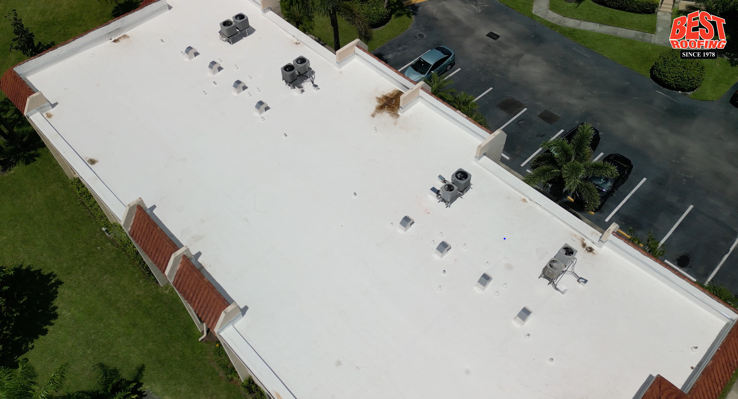Choosing the right roofing system for your commercial property is a big decision one that affects not just budget and performance, but also energy efficiency, long-term durability, and ongoing maintenance costs. Two of the most common flat or low-slope roofing systems in Florida are TPO (Thermoplastic Polyolefin) and Modified Bitumen. While both offer excellent protection when properly installed, they are fundamentally different systems with unique pros, cons, and ideal applications.
At Best Roofing, we've installed and maintained thousands of both systems across South Florida. Here's a side-by-side look at TPO vs. Modified Bitumen to help you make the best decision for your building.
What's the Difference Between TPO and Modified Bitumen?
Let's start with the basics:
TPO Roofing |
Modified Bitumen Roofing |
Single-ply membrane |
Multi-ply asphalt-based system |
Typically white, reflective surface |
Granulated, asphalt-like surface |
Heat-welded seams |
Cold adhesive, hot asphalt, or torch-applied seams |
Lightweight and flexible |
Thicker, more impact-resistant |
Newer system (since 1990s) |
Proven legacy system (since 1970s) |
The biggest distinction is that TPO is a single-ply thermoplastic membrane, while Modified Bitumen is a layered, asphalt-based system reinforced with polymers for added durability. Each is installed differently and performs differently under foot traffic, UV exposure, and standing water.
Pros and Cons of TPO Roofing

TPO has become the go-to choice for commercial buildings looking to reduce heat absorption and lower energy costs. Here's what makes it attractive:
Advantages
Highly reflective: TPO reflects up to 87% of UV rays, making it a popular choice for energy-efficient "cool roofs" in sunny climates like Florida.
Lightweight: Its single-ply construction makes it easier and faster to install on large surfaces.
Resistant to chemicals and pollutants: Ideal for restaurants, industrial buildings, or manufacturing sites.
Flexible in cold weather: TPO membranes handle thermal expansion and contraction well.
Ponding Water: TPO (Thermoplastic Polyolefin) is a single-ply roofing membrane that is inherently waterproof. It's designed to resist moisture infiltration, even in areas where water collects temporarily. The material is reinforced, UV-resistant, and seam-welded with heat, creating a watertight system that can withstand heavy rain and occasional standing water without breaking down.
Can be applied over existing roofs: In some cases, TPO can be installed as an overlay system, saving on tear-off costs.
Disadvantages
More vulnerable to punctures: Because it's only one layer thick, TPO can be easily damaged by dropped tools, sharp debris, or heavy foot traffic.
Not ideal for high-traffic roofs: If your roof is accessed frequently for HVAC servicing or maintenance, you may want something more durable.
Pros and Cons of Modified Bitumen Roofing

Modified Bitumen builds on the legacy of built-up roofing (BUR) systems, adding polymers to increase flexibility and performance. It's a great fit for buildings that require rugged durability and walkability.
Advantages
Multi-layer protection: With 2-3 layers of membrane, Modified Bitumen offers excellent redundancy against leaks.
Foot traffic resistance: The thicker surface can handle routine service visits and occasional foot traffic without damage.
Proven performance: Modified Bitumen has a long track record in the commercial roofing industry.
Variety of application methods: Depending on the building, it can be torch-applied, cold-adhesive applied, or hot-mopped.
Reflective granules available: Though not as reflective as TPO by default, reflective coatings can be added to reduce heat absorption.
Disadvantages
Vulnerable to ponding water: Bitumen systems don't drain as efficiently as single-ply membranes. Prolonged standing water can degrade the surface.
Harder to detect leaks: Because it's a multi-layer system, moisture intrusion can go undetected and spread before showing signs.
Less environmentally friendly: TPO has the edge when it comes to recyclability and chemical resistance.
Compatibility: Can TPO and Modified Bitumen Be Used Together?
Generally, TPO and Modified Bitumen are not directly compatible especially when it comes to adhesives, chemical bonding, and thermal expansion properties. If you're planning a roof tie-in or partial retrofit, your roofing contractor must take extra precautions to properly transition between the two systems using separator sheets or specific flashing details.
Which Roofing System Is Better for South Florida?
There's no one-size-fits-all answer. The right choice depends on your building's needs, roof traffic levels, budget, and long-term maintenance expectations.
Choose TPO if: |
Your building is exposed to high levels of sun and you're looking to improve energy efficiency. |
You want a lightweight, modern system with strong chemical resistance. |
Roof access is limited or controlled, minimizing puncture risk. |
Choose Modified Bitumen if: |
Your roof has frequent service traffic or equipment installations. |
You want multi-layered protection with proven performance over decades. |
Your roof design requires more robust waterproofing around penetrations or drains. |
Installation Matters More Than the Material

Whether you choose TPO or Modified Bitumen, proper installation by a qualified commercial roofing contractor is the most critical factor in long-term roof performance.
At Best Roofing, we don't just install roofs we help property owners make confident, informed decisions. We'll inspect your current system, assess your building's needs, and provide a clear recommendation backed by data and experience.
Final Thoughts
TPO and Modified Bitumen are both excellent commercial roofing systems when used in the right application. TPO excels in UV resistance and energy savings, while Modified Bitumen stands up to foot traffic and offers thick, multiple layers of protection.
If you're unsure which is best for your property, start with a professional roof inspection. Our team at Best Roofing will give you a detailed condition report, a transparent scope of work, and expert guidance every step of the way.
Schedule Your Free Roof Inspection Today
Don't wait until a roof issue disrupts your operations or drives up repair costs. Whether you're replacing a roof or comparing systems, a no-cost inspection is the first step to protecting your investment.
Book your inspection now or call our team to talk through your options.



